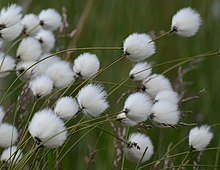Eriophorum
| Eriophorum | |
|---|---|

| |
| Eriophorum vaginatum | |
| Scientific classification | |
| Kingdom: | Plantae |
| Clade: | Tracheophytes |
| Clade: | Angiosperms |
| Clade: | Monocots |
| Clade: | Commelinids |
| Order: | Poales |
| Family: | Cyperaceae |
| Genus: | Eriophorum L. |
| Type species | |
| Eriophorum vaginatum L.
| |
| Synonyms [1] | |
| |
Eriophorum (cottongrass, cotton-grass or cottonsedge) is a genus of
temperate portions of the Northern Hemisphere in acid bog habitats, being particularly abundant in Arctic tundra regions.[2][3][4][5]
They are
perennial plants with slender, grass-like leaves. The seed heads are covered in a fluffy mass of cotton-like fibers which are carried on the wind to aid dispersal. The cotton grass also maintains a height of 12 inches and around 2 inches in water. In cold Arctic regions, these masses of translucent fibres also serve as 'down' – increasing the temperature of the reproductive organs during the Arctic summer by trapping solar radiation.[6]
tapeworm.[7]
Selected species
These species are included:[5][1]
- Eriophorum angustifolium Honck. – widespread across Europe, Asia, North America
- Eriophorum × beringianum Raymond – Alaska including Aleutians; Magadan region of Russia (hybrid E. angustifolium × E. chamissonis)
- Eriophorum brachyantherum Trautv. & C.A.Mey. – Scandinavia, northern Russia, Mongolia, Korea, Alaska, northern Canada
- Eriophorum callitrix Cham. ex C.A.Mey. – Siberia, Russian Far East, Alaska, Canada, Greenland, Montana, Wyoming
- Eriophorum chamissonis C.A.Mey. – Siberia, Russian Far East, Korea, Mongolia, Alaska, Canada, Greenland, northern and western United States
- Eriophorum crinigerum (A.Gray) Beetle – Oregon, northwestern California
- Eriophorum × fellowsii (Fernald) M.S.Novos. – Ontario, Maine, Massachusetts (hybrid E. virginicum × E. viridicarinatum)
- Eriophorum gracile Koch – much of Europe; northern and Central Asia; China, Tibet, Mongolia, Alaska, Canada, northern United States
- Eriophorum × gracilifolium M.S.Novos. – European Russia (hybrid E. gracile × E. latifolium)
- Eriophorum humile Turcz. – Altai, Tuva, Kazakhstan, Mongolia, Amur
- Eriophorum latifolium Hoppe – much of Europe; Caucasus, Turkey, Mongolia
- Eriophorum × medium Andersson – scattered locations in Finland, Norway, Russia, Alaska, Quebec, Labrador (hybrid E. chamissonis × E. scheuchzeri)
- Eriophorum × polystachiovaginatum Beauverd – France (hybrid E. angustifolium × E. vaginatum)
- Eriophorum × pylaieanum Raymond – scattered locations in Canada and Alaska (hybrid E. chamissonis × E. vaginatum)
- Eriophorum × rousseauianum Raymond – Alaska, Quebec (hybrid E. angustifolium × E. scheuchzeri)
- Eriophorum scabriculme (Beetle) Raymond – Vietnam
- Eriophorum scheuchzeri Hoppe – much of Europe; northern and Central Asia including Siberia, Xinjiang, Himalayas, Alaska, Greenland, Canada, mountains of western United States
- Eriophorum tenellum Nutt. – eastern Canada and northeastern United States from Nunavut and Labrador to New Jersey
- Eriophorum tolmatchevii M.S.Novos. – Krasnoyarsk, Yakutiya
- Eriophorum transiens Raymond – Guizhou
- Eriophorum vaginatum L. – most of genus range
- Eriophorum virginicum L. – eastern North America from Labrador to Tennessee, west to Michigan
- Eriophorum viridicarinatum (Engelm.) Fernald – Canada including Arctic territories; northern United States
References
- ^ a b "Eriophorum L., Sp. Pl.: 52 (1753)". eMonocot. Archived from the original on January 3, 2014. Retrieved May 10, 2013.
- )
- ^ Flora Europaea: Eriophorum
- ^ Flora of China, Vol. 23 Page 174, 羊胡子草属 yang hu zi cao shu, Eriophorum Linnaeus, Sp. Pl. 1: 52. 1753.
- ^ a b Kew World Checklist of Selected Plant Families
- ^ Crawford, R. M. M. (1989). Studies in Plant Survival. Blackwell Science. pp. 54–55.
- ^ This article incorporates text from a publication now in the public domain: . Collier's New Encyclopedia. 1921.
